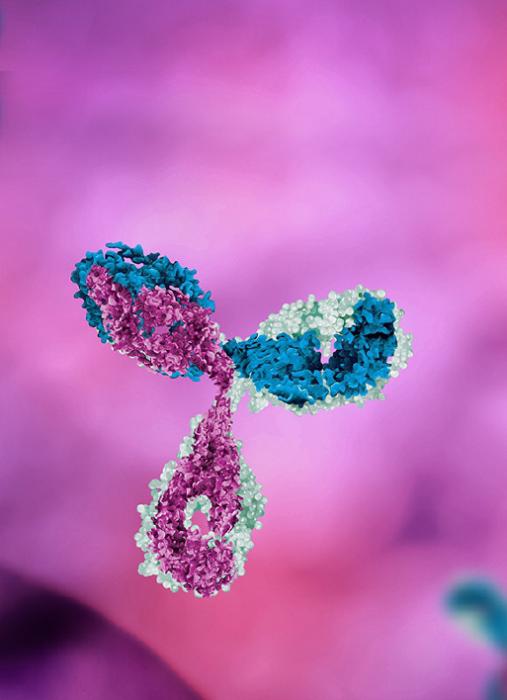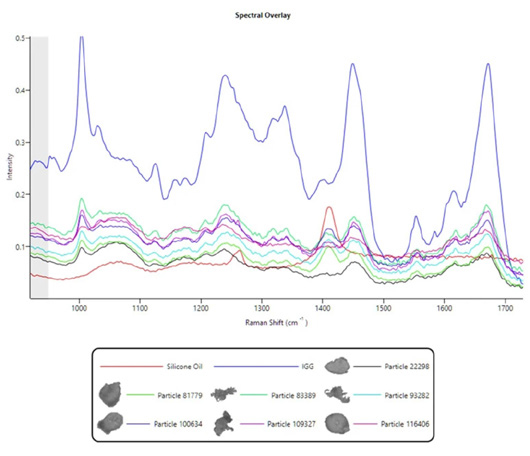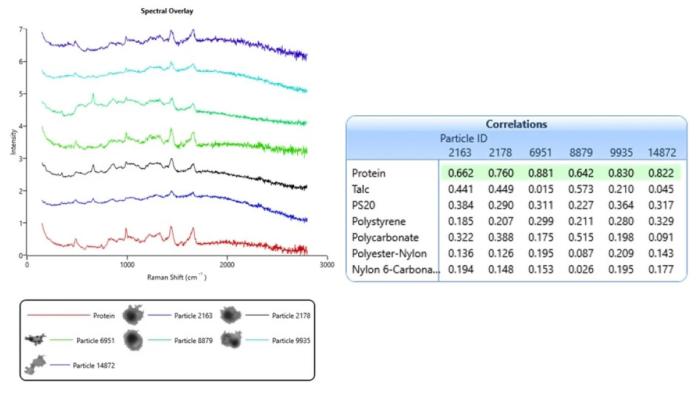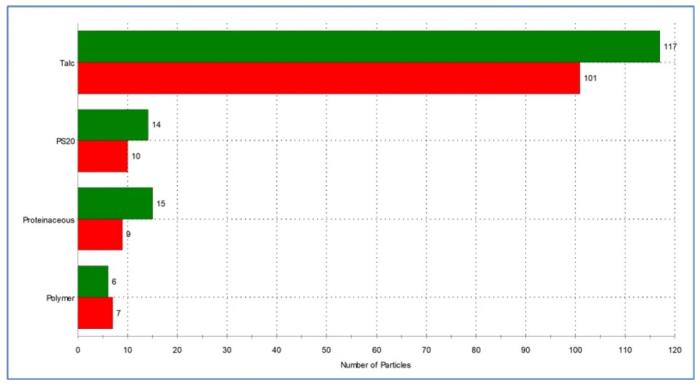Malvern Panalytical의 'AUTOMATED IDENTIFICATION AND COUNT OF SUBVISIBLE PARTICLES IN PARENTERAL BIOTHERAPEUTICS'에 관한 응용자료의 주요 내용은 다음과 같다.
Introduction
In terms of enumerating particulate matter in parenteral biotherapeutics, the regulatory position is covered in USP general chapters <787> and <788>. These chapters accept that some particulate matter may be present in the product, and limits are set based on the size and number of particles. However, not all particulate matter is ‘made equal’ and particles originate from a variety of sources. USP <1787> describes three different categories of particulate matter:
• Inherent: particles derived from the product itself, such as protein or excipient agglomerations
• Intrinsic: particles derived from the process, such as silicone oil, rubber or glass
• Extrinsic: particles derived from unknown sources
As USP <1787> informational chapter states:
“Because multiple potential sources of particles exist, it is important to identify the particles and determine whether they are extrinsic, intrinsic, or inherent. Once this has been accomplished, it is possible to develop and apply appropriate control strategies. If deviations occur, particle identity will guide the root cause analysis, risk assessment, corrective actions, and control strategy.”
One of the techniques for particle identification described in this chapter is Raman Microspectroscopy, which involves using a light microscope to target individual particles for Raman spectroscopy. The identification can be rapid and can take place in the native suspension or when filtered. However, locating these particles requires both a substantial amount of time and a highly-skilled operative.
In this application note, we describe an automated method of Raman Microspectroscopy whereby the sample is scanned, and particles are located by image analysis. The particles are then targeted for Raman analysis, according to their morphological descriptors. This technique is known as Morphologically-Directed Raman Spectroscopy(MDRS®), is performed using Malvern Panalytical’s Morphologi 4-ID, and is increasingly used to determine component-specific particle size and shape. In contrast to manual Raman microscopy, not only does the use of MDRS decrease the time and burden on the analyst, but it also enables enumeration of the particles and stores particle images with their spectral information. Thus, both the robustness of the test and the ability to audit the data are improved. Here we describe the use of MDRS for automatic identification and enumeration of particulate matter in a biotherapeutic product.
Analysis of suspended or filtered samples
When performing foreign particle analysis on protein formulations using the Morphologi 4-ID, one of two sample preparation methods can be used, depending on the specific requirement:
1. Sample is prepared as a suspension and dispersed in the Thin Path Wet Cell
2. Sample is filtered using fused silica filters
Characterizing particles in their native state is preferable to any further processing because the preparation process itself might induce changes in the sample. For example, drying out protein particles will likely change their size and shape and the very action of filtering may promote aggregation. The Thin Path Wet Cell enables the analysis of samples in their native state, but this method may present challenges for the analyst. The first of these challenges is the possibility of collecting images of very low contrast particles. Fully-hydrated proteins suspended in an aqueous medium can be very difficult to see with light microscopy. Using the Sharp Edge Low Contrast segmentation algorithm can help solve this issue, as seen in the example particle images in Figure 1.
Figure 1. Example images of low contrast protein particles suspended in an aqueous medium
The second challenge is the collection of Raman spectra from low-density protein particles via a quartz window. This is very relevant for proteins as they typically have a low Raman cross-section, meaning they are weak Raman scatterers and can be challenging to identify. The recommendation therefore is to use high laser power and increase the exposure time for Raman collection. The spectra seen in Figure 2 are from protein particles analyzed using the Thin Path Wet Cell with an exposure time of 300 seconds. Longer exposure times of 600 seconds have also been used to identify very weak Raman scatterers, but this inevitably limits the number of particles that can be identified in a given timeframe.
Figure 2. Thin Path Wet Cell Raman spectral data from protein and protein-silicone oil agglomerated particles compared against silicone oil (red) and protein(IGG, blue) reference spectra
Interestingly, there is a clear peak around 1410cm-1 in the protein spectra in Figure 2. This may be identified as silicone oil a known lubricant and typically an intrinsic particle. This is a further benefit to analyzing the sample in its native state using the Thin Path Wet Cell, as immiscible oils such as silicone oil will pass through filter substrates or spread too thinly on them to be identified.
Particle identification using Raman spectroscopy
The objective of this test is to positively identify particles by comparing their Raman spectra against a library of standard spectra. Figure 3 shows spectra from six particles and a protein reference spectrum. The table contains the library of reference spectra used in this test and the particles’ spectral correlation scores. All six spectra in Figure 3 correlate most closely with the protein reference spectrum, highlighted in green.
Figure 3. Raman spectra from a sample taken from a fused silica filter, showing correlation scores to reference library spectra
High correlation scores are also dependent on Raman spectral quality. As discussed above, using high laser power and long exposure times will improve spectral quality. The sample analyzed in Figure 3 was prepared on a fused silica filter substrate.
Here, there was no quartz window or suspension medium to interfere with the laser light path. Furthermore, the protein particles were somewhat dehydrated, which increased their density. This did mean that their size and shape were likely different from their native state, but the benefit was an increase in Raman signal. As a result, the exposure times for these spectra was 30 seconds shorter than those from the Thin Path Wet Cell in Figure 2 by a factor of 10.
As described above, Raman exposures of 30 seconds - 600 seconds for these types of particles can be expected. But what exposure time is required to give a satisfactory result?
Using MDRS to explore the balance between Raman exposure time and data quality
Using the fully-automated MDRS method and fused silica filters, a protein sample was analyzed using exposure times of 30seconds and 300 seconds. As expected, the Raman spectral quality was higher when collected for 300 seconds(data not shown). However, as Figure 4 shows, whilst there were minor differences between absolute particle numbers collected during the two exposure times, their relative proportions remained approximately the same, and showed that the protein sample was highly contaminated with talc and polymer. These types of materials could be intrinsic or extrinsic. There were also proteinaceous aggregates and polysorbate 20 particles present, which were likely inherent. As a result of such analysis, a control strategy could be developed to establish if a deviation had occurred.
Figure 4. Particle identification and count for the protein sample prepared using a fused silica filter and analyzed using MDRS. Raman exposure times of 300s(green) and 30s(red).
Conclusion
Fundamentally, the objective of using Raman microspectroscopy for the analysis of parenteral biotherapeutics is to identify enough particles to establish if a deviation has occurred. This requires identifying and categorizing particles as inherent, intrinsic or extrinsic, and setting a control strategy for each. However, amorphous protein particles have considerably weaker Raman spectra than their crystalline equivalents. This necessitates a longer exposure time to positively identify the material as protein, which will substantially increase the overall analysis time. However, this should be balanced against the objective of the test. Is it useful to identify proteinaceous materials, or is it more important to establish the nature of other materials in the sample? As such, it is recommended to explore the exposure times required for identification.
Choosing to analyze the sample in its native state using the Thin Path Wet Cell has its benefits, including the avoidance of disruption of protein particle shape and size. However, the quality of the Raman data may be compromised, which in turn may compromise the objective of the test. Therefore, it is also recommended to explore the different dispersion methods of suspension and filtration, during method development.
Finally, by automating the test using the MDRS technique, both qualitative and quantitative chemical information can be derived with a minimal burden on the analyst. This leads to a more rigorous test and a more robust control strategy.
Malvern Panalytical의 'Morphologi 4-ID'에 대한 궁금한 내용은 본 원고자료를 제공한 말번 파날리티칼 코리아를 통하여 확인할 수 있다.
Reference(참고자료): 말번 파날리티칼 응용노트
1. https://www.uspnf.com/
2. United States Pharmacopeia general information chapter 1787: Measurement of Subvisible Particulate Matter in Therapeutic Protein Injections.
3. Price R, Farias G, Ganley W, Shur J. Demonstrating Q3 Structural Equivalence of Dry Powder Inhaler Blends: New Analytical Concepts and Techniques, Respiratory Drug Delivery 2018. Volume 1, 2018: 265-276.
4. Liu Q et al, Scientific Considerations for the Review and Approval of First Generic Mometasone Furoate Nasal Suspension Spray in the United States from the Bioequivalence Perspective, The AAPS Journal (2019) 21: 14
5. FDA/CDER SBIA Chronicles: FDA embraced emerging technology for bioequivalence evaluation of locally acting nasal sprays. [www.fda.gov/downloads/Drugs/DevelopmentApprovalProcess/SmallBusinessAssistance/UCM502012.pdf].
6. Davies et al, Investigation of DPI Particle Microstructure by MDRS to Explain The Difference Observed in NGI Results Between Equivalent Productshttps://www.copleyscientific.com/downloads/poster-december-2019/
Model Name(모델명): Morphologi 4-ID
The Person in Charge(담당자): Kim Seungji
Maker(제조사): Malvern Panalytical
Country of Origin(원산지): UK
Mail inquiry: korea.info@malvernpanalytical.com
Data Services(자료제공): Malvern Panalytical Korea
<이 기사는 사이언스21 매거진 2023년 6월호에 게재 되었습니다.>








